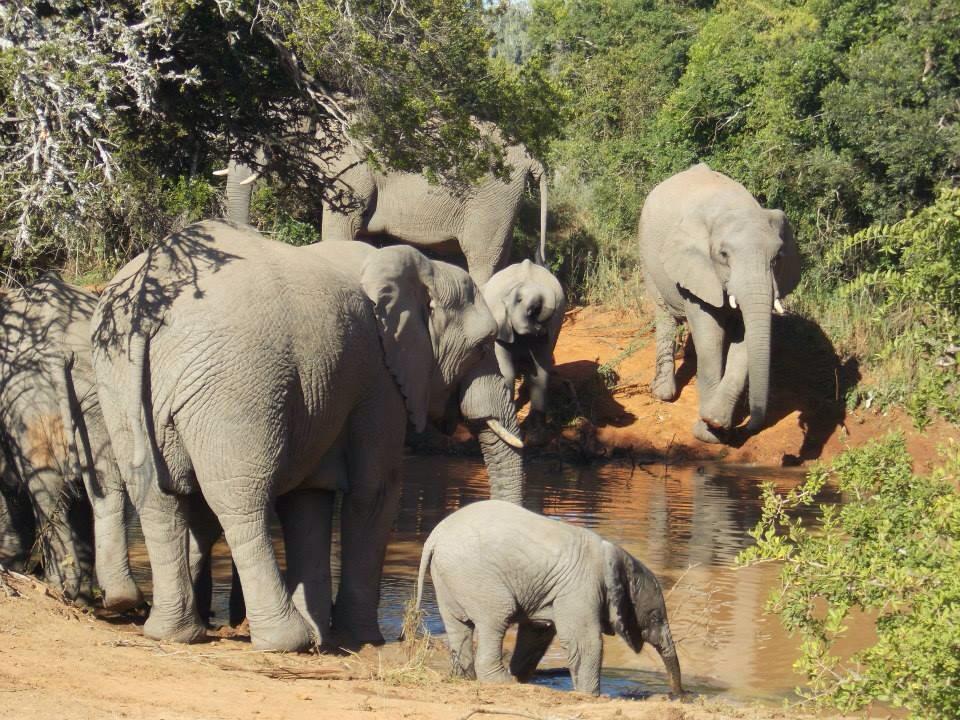History of the Kariega elephants
Local writer and conservationist Bart Logie shares memories and the history of Kariega elephants
As we bumped down the track at Kariega Game Reserve, Jacques Matthysen, our guide, pointed to the dense bush on the other side of the valley. Moments later the ponderous bulk of a mother elephant emerged, followed by a waggle-trunked baby. We stopped to watch. Apart from the odd rustle of leaves and the crack of a breaking branch these immense animals made no noise as they brushed their way through the dense coastal scrub and into the open valley. Only later, as they drew nearer, did we hear their almost subliminal tummy rumblings.

Eastern Cape had one of the greatest concentrations of elephants on the African continent
John Barrow, secretary to Lord Macartney during the first British occupation of the Cape (1803-1806), was the first to put pen to paper regarding the elephants between the Kasouga and Kariega Rivers. Numerous Dutch farmers hunted the great creatures long before Barrow arrived, but the hunters were no diarists, in fact many may well have been to all intents and purposes illiterate. One of them, “Rensburg” according to Barrow, told him that there were between 400 and 500 elephants between the two rivers. Halving these numbers to allow for exaggeration still leaves a herd of very significant size.
With the arrival in the area in 1820 of British settlers, the elephants came to be viewed as a distinct menace. A certain Mr Clarke was seen chasing an elephant from the vicinity of his tent with the only weapon he had to hand, a broad bladed axe, and by 1822 the Game Laws were amended because of the extensive damage done by these animals. The following year it was recorded that elephants had been using George Dyason’s house “as a rubbing post, to its great danger.” Meanwhile Cypress Messer, the “steward” (farm manager) on Barville Park not far east from Kariega Game Reserve, in a letter to a friend mentioned elephants, buffaloes “and many sorts of animals”. My great-grandfather, while not illiterate but certainly more at home with a muzzle-loading rifle or broad bladed axe than a quill or steel-nibbed pen, was on the same farm when he came across elephants. In his old age he regaled his grandchildren with tales of his adventures with these soft-footed, but often unpredictable giants, and in due course my father passed on these stories to me.
In 1826 the Rev George Barker rode from Theopolis Mission to the mouth of the Kasouga (visible from the restaurant at Kariega) to rescue Alexander McDonald and his wife who “had been alarmed by the aggressiveness of the elephants around the camp there”. For generations members of my family spent summer holidays at the mouth of that river, and some of my great-grandfather’s stories, told around a camp-fire situated beneath the spreading branches of a milkwood, were about the Kasouga/Kariega elephants.
Elephants disappear from Kariega area after 1910
A 1910 Game Census listed 40 elephants in the Bathurst district immediately to the east of Kariega, but by 1912 a local farmer, Mr Frank Bowker, denied a report that there were still elephants in the Bathurst district. In that year my father turned 24 and he certainly never remembered seeing in his lifetime any elephants along the coast. So it seems that during the early years of the 20th century the elephants disappeared from the Kariega Game Reserve area. At the time there were, no doubt, many who gave a sigh of relief at the news.
Conservation efforts bring back elephant to Kariega and the Eastern Cape
Today in the Eastern Cape, thanks largely to private wildlife conservation efforts, elephants have returned to an environment where they are surrounded by food and never far from water. No wonder they always favoured this area, resulting in one of the greatest concentrations of elephants on the African continent.
Delighted as we were to see them emerge from the thicket we were aware of the management problems to which their presence gives rise. Long before the Kariega herd ever reached the vicinity of 400 to 500 animals it would cause problems commensurate with the size of the elephants. We were thankful that others have this responsibility and that we needed only to sit back and enjoy the company of these wonderful creatures.
Much of the historical material for this blog was gleaned from:
Skead, CJ. 2007. Historical Incidence of the Larger Land Mammals in the broader Eastern Cape, Second Edition (eds: Boshoff, AF., Kerley, GIH and Lloyd, PH.). Port Elizabeth: Centre for African Conservation Ecology, Nelson Mandela Metropolitan University.









